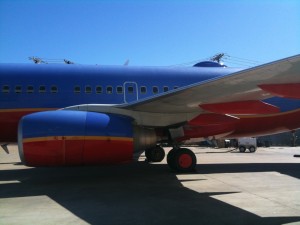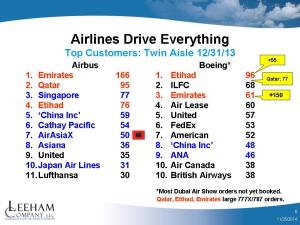Leeham News and Analysis
There's more to real news than a news release.
Air Canada: 787s have 29% lower costs than older 767s (before the latter’s reconfiguration)
Dec. 2, 2014: Air Canada says its new Boeing 787s will have 29% lower fuel, maintenance and per-seat costs than the old Boeing 767-300ERs being replaced.
Part of this is because the 787s seat more passengers.
But the airline has found new life in the 767s through increased density, shifting them to its low cost carrier, Rouge, which has lower labor costs and overhead. Rouge’s 767s have 30% lower CASM costs than the same airplane at mainline Air Canada. Read more
Oil heading toward $40? Economist still thinks so, with caveats; and: NTSB issues 787 battery report, Azul’s A320/CFM order
Dec. 1, 2014: Adam Pilarski, an economist for the consulting firm Avitas, predicted several years ago that the price of oil would drop to $40bbl. Few believed him.
Oil hit $66 this week, on a steady decline over the past months, and, according to an article by Bloomberg News, could be on its way to $40.
Pilarski, who originally made his prediction in 2011 at a conference organized by the International Society of Transport Aircraft Traders (ISTAT). He predicted this price by October 2018.
In an interview with Leeham News today, Pilarski concurs that oil may hit $40 soon, though he believes the low end will be in the $40-$50 range. The low price will not for the reasons he outlined in 2011 and neither will it stay at or near $40 for long.
Happy Thanksgiving, 2014
Today we’re watching the Seattle Seahawks…Go Hawks!
We’re off until Monday.

Fundamentals of airliner performance, Part 4
By Bjorn Fehrm
Nov. 25, 2014: In our article series around the performance of a modern airliner we have now come to the climb after takeoff.  We started with cruise as this was simplest because the aircraft is flying in steady state, then we looked at the modern turbofan and how this is affected by both altitude and speed. We then examined how this affects the takeoff and today we continue with the climb after takeoff.
We started with cruise as this was simplest because the aircraft is flying in steady state, then we looked at the modern turbofan and how this is affected by both altitude and speed. We then examined how this affects the takeoff and today we continue with the climb after takeoff.
Before we start, let’s sum up a few points we need for today:
- Drag is the one thing we always need to be aware of as this regulates how much excess power we have in different flight situations and therefore if we can stay on our altitude or climb.
- Drag diminishes with altitude as the airs density diminishes and thereby our dominant drag component, air friction against our aircraft’s skin. This is the major component of the aircraft’s dominant drag, parasitic drag.
- Our lift force is generated by forcing air downwards and this causes induced drag as this downwash cost energy to generate and maintain. Induced drag is mitigated by a wing with a large span.
Odds and Ends: Korean tanker competition sounds like US rerun; About that blister on the top of airliners; JetBlue explains bags, seats
Korean tanker competition: South Korean is holding a competition for an aerial refueling tanker and in many respects, it sounds like a rerun of the USAF competition between Airbus and Boeing.
In the US contest, major debates happened over Bigger vs Smaller between the A330-200-based KC-330 MRTT and the 767-200ER-based Boeing tanker, which ultimately won and which was named the KC-46A.
This article neatly sums of this same issue in the Korean competition. It’s a matter of greater range, more fueling capacity, vs “enough” and better airport access; and global compatibility.
About that blister: Have you ever noticed the big “blister” in the top of airliner

The “blister” on top of the fuselage contains internet connectivity antennae. The power line appearing to come out of the top of the blister is not part of this. Source: AirlineReporter.com
fuselages? This is for Internet connectivity, an increasingly popular feature on airlines as passengers bring their own Nookbooks, iPads and the like to watch movies or cruise the Net. But aircraft lessors apparently don’t find these features all that desirable and are increasingly talking about having airlines take them out at the end of lease terms. Mary Kirby of Runway Girl Network has this story on the esoteric topic.
JetBlue explains bags, seats: JetBlue is reducing seat pitch and adding bag fees. CFO Mark Powers explains these moves in a Bloomberg News interview.




